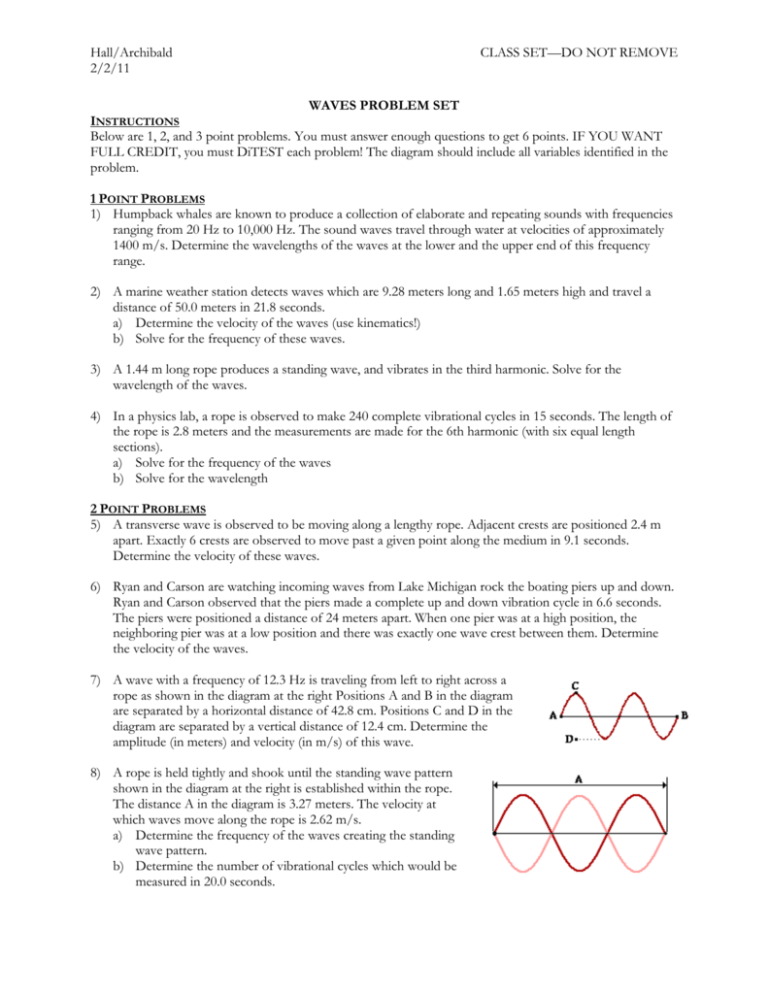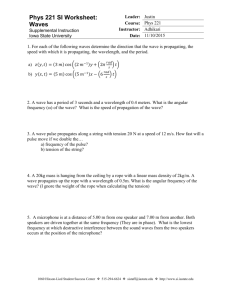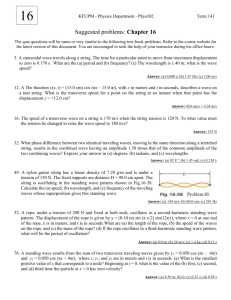waves PS1 - mshallarvadahs
advertisement

Hall/Archibald 2/2/11 CLASS SET—DO NOT REMOVE WAVES PROBLEM SET INSTRUCTIONS Below are 1, 2, and 3 point problems. You must answer enough questions to get 6 points. IF YOU WANT FULL CREDIT, you must DiTEST each problem! The diagram should include all variables identified in the problem. 1 POINT PROBLEMS 1) Humpback whales are known to produce a collection of elaborate and repeating sounds with frequencies ranging from 20 Hz to 10,000 Hz. The sound waves travel through water at velocities of approximately 1400 m/s. Determine the wavelengths of the waves at the lower and the upper end of this frequency range. 2) A marine weather station detects waves which are 9.28 meters long and 1.65 meters high and travel a distance of 50.0 meters in 21.8 seconds. a) Determine the velocity of the waves (use kinematics!) b) Solve for the frequency of these waves. 3) A 1.44 m long rope produces a standing wave, and vibrates in the third harmonic. Solve for the wavelength of the waves. 4) In a physics lab, a rope is observed to make 240 complete vibrational cycles in 15 seconds. The length of the rope is 2.8 meters and the measurements are made for the 6th harmonic (with six equal length sections). a) Solve for the frequency of the waves b) Solve for the wavelength 2 POINT PROBLEMS 5) A transverse wave is observed to be moving along a lengthy rope. Adjacent crests are positioned 2.4 m apart. Exactly 6 crests are observed to move past a given point along the medium in 9.1 seconds. Determine the velocity of these waves. 6) Ryan and Carson are watching incoming waves from Lake Michigan rock the boating piers up and down. Ryan and Carson observed that the piers made a complete up and down vibration cycle in 6.6 seconds. The piers were positioned a distance of 24 meters apart. When one pier was at a high position, the neighboring pier was at a low position and there was exactly one wave crest between them. Determine the velocity of the waves. 7) A wave with a frequency of 12.3 Hz is traveling from left to right across a rope as shown in the diagram at the right Positions A and B in the diagram are separated by a horizontal distance of 42.8 cm. Positions C and D in the diagram are separated by a vertical distance of 12.4 cm. Determine the amplitude (in meters) and velocity (in m/s) of this wave. 8) A rope is held tightly and shook until the standing wave pattern shown in the diagram at the right is established within the rope. The distance A in the diagram is 3.27 meters. The velocity at which waves move along the rope is 2.62 m/s. a) Determine the frequency of the waves creating the standing wave pattern. b) Determine the number of vibrational cycles which would be measured in 20.0 seconds. Hall/Archibald 2/2/11 CLASS SET—DO NOT REMOVE 3 POINT QUESTIONS 9) A standing wave is established in a slinky as shown in the diagram at the right. The distance from point A to point B is known to be 4.69 meters. When not being vibrated as a standing wave, a single pulse introduced into the medium at point A will travel to the opposite end and back in 2.70 seconds. Determine the vibrational frequency of the wave pattern. 10) A standing wave pattern is established in a 2.46 m long rope. A snapshot of the rope at a given moment in time is shown in the diagram below. A single pulse can travel the length of the rope and back in 0.22 s. Determine the frequency of vibration of the rope.








